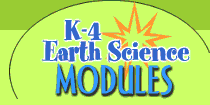Topic Overview: Spheres
You may know that a round object is called a sphere. The world is full of spheres. Marbles, beach balls, and globes are all spheres. The sun and Earth are giant spheres. You may not know that the word sphere has a second meaning. A sphere is also where something acts or exists. This type of sphere is not always round.
Earth system scientists divide all things on Earth into one of four spheres. These four spheres are land, water, living things, and air. Everything on Earth exists in one of these spheres.
 Land includes all forms of soil and rock in Earth's system. The surface of Earth's land is very uneven. The image at the right shows this. There are high mountains like the Rockies and Andes (shown in red). There are huge plains or flat areas like those in Texas, Iowa, and Brazil (shown in green). There are also deep valleys along the ocean floor (shown in blue). Land includes all forms of soil and rock in Earth's system. The surface of Earth's land is very uneven. The image at the right shows this. There are high mountains like the Rockies and Andes (shown in red). There are huge plains or flat areas like those in Texas, Iowa, and Brazil (shown in green). There are also deep valleys along the ocean floor (shown in blue).
If you could cut through the center of Earth, you would see layers of land. Earth's layers of land are like the layers of an onion. The outermost layer of land is loose soil. Beneath the soil is a very thin, solid crust. Below the crust is a thick, semisolid layer of rock. This layer is called the mantle. The mantle is like Silly Putty®. The mantle is a solid, but it can move and stretch. Below the mantle is a layer of liquid rock. This layer is called the outer core. The inner core is made of solid rock. It is at the center of Earth.
There is a lot of water on Earth. Water is in the oceans and rivers. They flow across the planet's surface. Water flows under Earth's surface too. This water is called groundwater. There are also tiny droplets of water in the sky. They make up the clouds. Water is even found inside Earth's living things!
 There are two major types of water: saltwater and freshwater. Most of Earth's water is salty, 97 percent in fact. Saltwater collects in deep basins along Earth's surface. These large collections of saltwater are the seas and oceans. Earth's seas and oceans are depicted in purple-to-blue in the above image. These salty bodies of water cover nearly three-fourths of the planet. Only a small portion of Earth's water is fresh (nonsalty). Most living things need to drink freshwater to survive. Freshwater falls as precipitation (rain, snow) from the air. The water can then flow in rivers and streams along Earth's land surface. Most of Earth's freshwater, however, is frozen in polar ice caps, glaciers, and icebergs. There are two major types of water: saltwater and freshwater. Most of Earth's water is salty, 97 percent in fact. Saltwater collects in deep basins along Earth's surface. These large collections of saltwater are the seas and oceans. Earth's seas and oceans are depicted in purple-to-blue in the above image. These salty bodies of water cover nearly three-fourths of the planet. Only a small portion of Earth's water is fresh (nonsalty). Most living things need to drink freshwater to survive. Freshwater falls as precipitation (rain, snow) from the air. The water can then flow in rivers and streams along Earth's land surface. Most of Earth's freshwater, however, is frozen in polar ice caps, glaciers, and icebergs.
Earth's living things include microorganisms, plants, and animals. Living things form communities based on their physical surroundings. Their physical surroundings include the land, air, and water in an area. These communities of living things are called biomes. Deserts, grasslands, and tropical rainforests are three of the many types of biomes.
Earth's air is made up of gases. Oxygen is one of the gases in Earth's air. This gas is important. Most living things breathe oxygen. They need it to stay alive. The air is also where Earth's weather occurs. Weather is the daily change in temperature, wind, rain, etc. |











